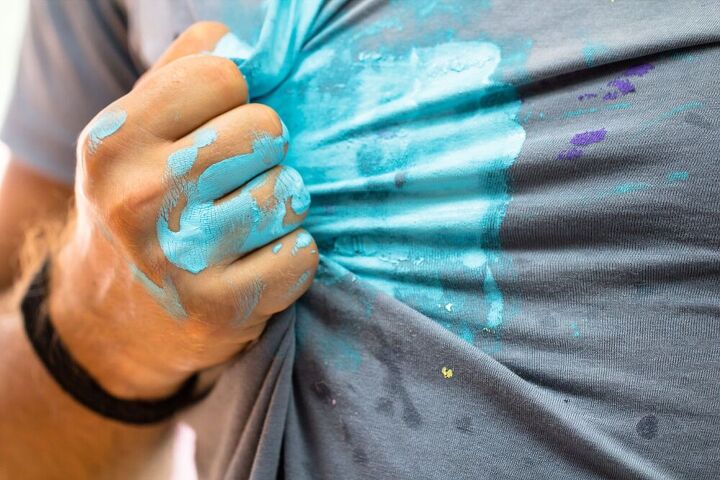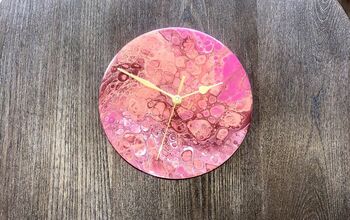Don't Panic: Here's How to Get Paint Out of Clothes

Adding a fresh coat of paint to the surfaces in your home is one of the easiest ways to change the atmosphere of a room, minus the time and renovations that come with major demo projects. All it takes are some brushes, tape, and some color.
But no matter how careful a painter is, it’s inevitable that paint will get on not only hands but clothes, too. Luckily, we’ve got a guide for how to get paint out of clothes for when that time comes.
Photo via Shutterstock
It’s important to note that painting is a home project you dress for, so it’s best to be prepared and have an old T-shirt and sweats on hand to wear.
Whether you’re determined to soak the paint out of your high school gym shirts or you’ve accidentally spattered some paint on a nicer piece from your wardrobe, the important thing to know is that paint can be removed from clothing, so don’t toss out your garments quite yet.
Here are several different factors of getting paint out of clothes to consider.
Removing Paint from Different Clothing Fabrics
It’s a given, but don’t just throw your paint-stained top in the washer—being aware of the type of fabric and paint you’re working with might just save your favorite blouse in the end. Compare silk and cotton, for example. Silk is a delicate material that requires the utmost care when washing and drying, whereas sturdy cotton jeans can withstand harsher treatments.
Check the Label
The very first thing you should do with a clothing item that’s been stained with paint is to check the garment label and take note of any care instructions.
Pay close attention to whether or not the piece is dry clean only; for washing items like silk, this doesn’t mean that you aren’t able to wash it at home, but the process will change slightly. If an item is able to be washed, great, because that’s exactly what you’ll need to do.
Blot and Pretreat
How you approach paint removal depends on the specific kind of paint you’re dealing with—oil, acrylic, latex, etc. The details are addressed below, but generally, it’s smart to treat the stain as soon as possible by blotting out—not scrubbing in—any excess paint.
To do so, take a dry cloth or paper towel and carefully dab the stain. The goal here is to absorb any excess liquid from the material, without pushing it further into the fabric.
For silk garments, blotting should be done gently and followed with a stain pretreatment specifically for the material, finished with a soak in warm water. Safe bets for strong cleaning power pretreatments are OxiClean or Shout stain removers or similar products.
To get paint out of sturdier fabrics, like denim, still blot and treat, but know that the cloth can take more of a vigorous scrubbing and will most likely benefit from a whirl in the washer afterward. Be mindful that this might not be a one-and-done process. While paint can come out, it's a stubborn medium to deal with, so it might take a few repeated steps here and there before the stain is lifted completely.
Once you’ve established the fabric you’re dealing with, remember that the paint removal process will likely change depending on the type of paint you’re dealing with. Here’s what you need to know about washing out different paint types.
Photo via Claire at Pillarboxblue
How to Get Acrylic and Latex Paint Out of Clothes
The most important thing to note when dealing with water-based mediums like acrylic paint, indoor and outdoor latex paints, and poster paints is that they will lift with soap. Most paints that you use on the ceilings and walls in your home, unless stated otherwise, are acrylic or latex-based.
Here’s how to remove acrylic and latex paints from your clothes:
Materials and Tools Needed
- Butter knife or putty scraper
- Laundry detergent or dish soap
- Rubbing alcohol (optional)
- Warm water
- Soft brush
1. Scrape
If the paint is still semi-wet, scrape off as much of it as you can using the dull side of a butter knife or a putty scraper. The less paint left, the better.
2. Spot Treat
Spot treat the stain using laundry detergent or dish soap. Rubbing alcohol works well for tougher garments like jeans. Blot with warm water, and if necessary, gently scrub with a soft brush or your fingertips.
3. Throw in Laundry and Repeat if Needed
Launder according to garment label instructions.
Depending on the size of the stain, you may need to repeat the process. Be sure to not place your clothing in the dryer if the stain isn’t completely lifted yet, otherwise, the paint will set on your clothes for good.
Photo via Jessica Hill
How to Get Oil Paint Out of Clothes
Oil-based paints—from craft tubes to interior or exterior paint buckets—can be a bit trickier to get out of clothes. Because this medium is made with oil, trying to scrub stains out with water and soap will likely make the stains worse, since the two won’t mix with oil.
Trade the water for a solvent of some sort to help break down the oil. Solvents include paint thinners and turpentine, and the paint you used will most likely have a recommended one listed on the product label. If you use anything too intense, you risk damaging your fabric for good.
If you do decide to use paint thinner or turpentine, do so with rubber gloves in a well-ventilated area.
Materials and Tools Needed
- Solvent or paint thinner
- Butter knife or putty scraper
- Clean rag
- Paper towel
1. Check Instructions and Scrape
Check the back of your paint can to see if there are any instructions to follow. Generally, most oil paints require a solvent or paint thinner, like Klean Strip, to help lift the stain, but most brands require specific ones.
Scrape off any excess paint using a dull end of a butter knife or a putty scraper.
2. Blot
Use the solvent or paint thinner to moisten a clean rag, and then begin to blot the stained area, making sure to rotate the rag to a clean spot so you aren’t continuously dabbing paint back into the stain. Don’t forget to place a few layers of paper towel under your fabric—this will help absorb the paint thinner.
3. Rinse and Launder
Rinse and spot clean with detergent before laundering as usual.
How to Get Spray Paint Out of Clothes
If you have prior experience cleaning paint out of your clothes, removing spray paint from any of your garments will follow a similar process.
As previously mentioned, first check to see if you are dealing with water-based acrylic or latex spray paint, or oil-based spray paint. The only other component to spray paint that separates it from the paint gallons in your basement is the aerosol, which makes it sprayable.
Once you’ve determined the type of paint you’re dealing with, you can treat it with either of the methods above.
Turpentine, a distilled oil from pine tree resin, is a popular solution to dealing with oil-based paints if you can’t find the exact solvent you are looking for.
Photo via Alicia W
How to Get Dried Paint Out of Clothes
Timing is key when it comes to removing paint stains from your clothing items. The sooner you’re able to get to a stain, the better.
Effectively dealing with dried paint stains isn’t impossible, but it will take a little more patience and luck. Here are some tips for removing set-in paint stains:
1. Scrape
Scrape off as much of the dry paint as you can using a stiff-bristled or wired brush.
2. Saturate
Once most of the dried paint is scraped off, saturate the stain. For water-based paints, use warm water and let a heavy-duty stain remover sit for several minutes. For oil-based paints, saturate the stain with a solvent or paint thinner.
3. Rinse and spot clean
Rinse and spot clean (using the steps above) before laundering as usual. If the stain remains, don’t dry it—that will only set the stain.
Repeat the steps until the stain is completely lifted.
Dealing with paint stains is tough, but it isn’t impossible. Once you’ve successfully cleaned some paint spatter out of your garments, you’re likely to wear clothes you don’t mind adding some color to on your next project.
Do you have a tried and true method for specific fabrics? Share below!






























Frequently asked questions
Have a question about this project?